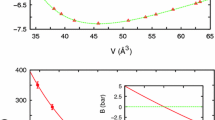Abstract
The problem of3He mobility in dilute3He-4He solid mixtures has been treated both theoretically and experimentally. The Hamiltonian of the system can be reduced to the Hamiltonian of strongly interacting impurity quasiparticles corresponding to some time-averaged states. The experiments carried out on solid mixtures with3He concentration 2.17%, 0.75%, 0.25%, or 0.092% by the NMR method show that at sufficiently low (T<1.2 K) temperatures the diffusion coefficient becomes temperature independent and inversely proportional to3He concentration. These results substantiate qualitative conclusions of the theory. Analysis of the experimental data makes it possible to take into account the phonon part of the3He diffusion coefficient and to obtain, up to a constant, the3He-4He exchange energyJ∼10−7 K. All the facts mentioned above testify to the substantially quantum nature of the3He diffusion process in dilute3He-4He mixtures.
Similar content being viewed by others
References
A. F. Andreev and I. M. Lifshitz,Zh. Eksperim. i Teor. Fiz 56, 2057 (1969) [English transl.,Soviet Phys.—JETP 29, 1107 (1969)].
R. A. Guyer, R. C. Richardson, and L. J. Zane,Rev. Mod. Phys. 43, 532 (1971).
A. Widom and M. G. Richards,Phys. Rev. 6A, 1196 (1972).
V. A. Slusarev and M. A. Strzhemechny,Low Temperature Physics (Russ.) Kharkov 19, 85 (1972).
V. N. Grigoriev, B. N. Esel'son, V. A. Mikheev, and Yu E. Shulman,Zh. Eksperim. i Teor. Fiz., Pisma 17, 25 (1973).
N. N. Bogolyubov, Sr,Collected Works (in Russian) (Kiev, 1970), Vol. 2.
T. L. Hill,Statistical Mechanics (McGraw-Hill, New York, 1956).
T. Burke, K. G. Major, and G. V. Chester,Ann. Phys. (N.Y.)42, 144 (1967).
V. A. Slusarev and M. A. Strzhemechny,Ukr. Fiz. Zh. 14, 45 (1969).
A. Abragam,The Principles of Nuclear Magnetism (Clarendon Press, Oxford, 1961).
E. Hahn,Phys. Rev. 80 (1950).
H. Y. Carr and E. M. Purcell,Phys. Rev. 94, 630 (1954).
R. L. Garwin and H. A. Reich,Phys. Rev. 115, 1478 (1959).
V. N. Grigoriev, B. A. Gulin, B. N. Esel'son, V. D. Korepanov, and V. A. Mikheev,Condensed State Physics (Russ.)Kharkov 10, 166 (1970).
E. R. Grilly and R. L. Mills,Ann. Phys. (N.Y.)18, 250 (1962).
W. J. Mullin,Phys. Rev. Letters 20, 254 (1968).
V. N. Grigoriev, B. N. Esel'son and V. A. Mikheev,Zh. Eksperim. i Teor. Fiz. 64, 608 (1973).
M. G. Richards, J. Pope, A. Widom,Phys. Rev. Letters 29, 708 (1972).
D. O. Edwards and R. C. Pandorf,Phys. Rev. 140A, 816 (1965).
Author information
Authors and Affiliations
Rights and permissions
About this article
Cite this article
Grigoriev, V.N., Esel'son, B.N., Mikheev, V.A. et al. 3He impurity excitations in solid4He. J Low Temp Phys 13, 65–79 (1973). https://doi.org/10.1007/BF00654398
Received:
Issue Date:
DOI: https://doi.org/10.1007/BF00654398




